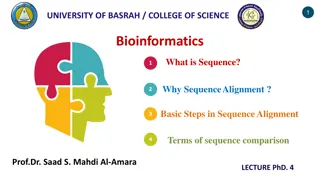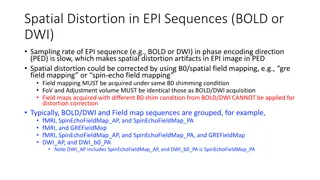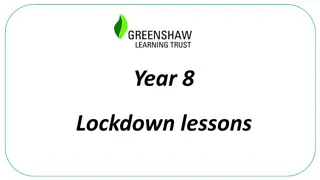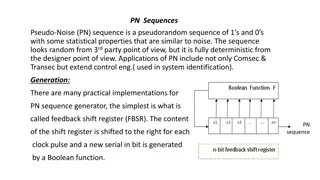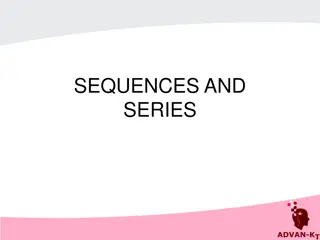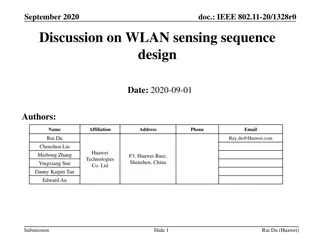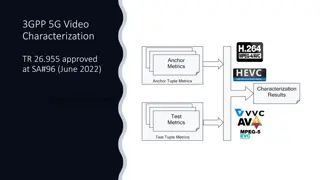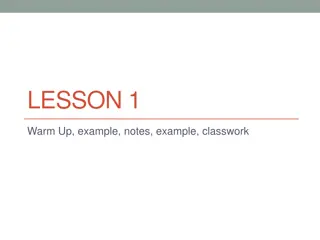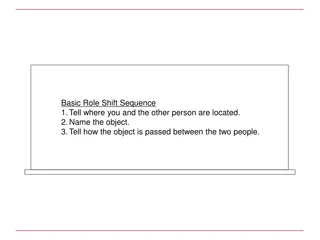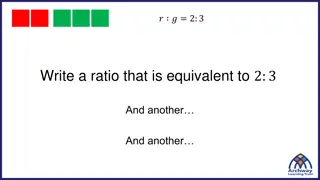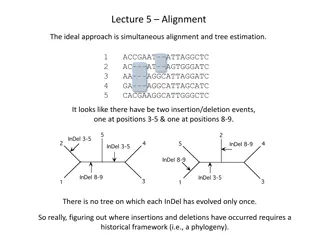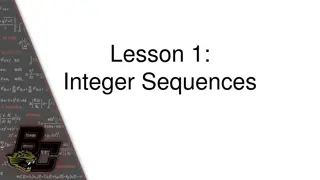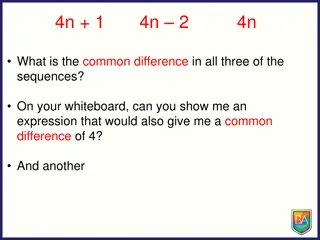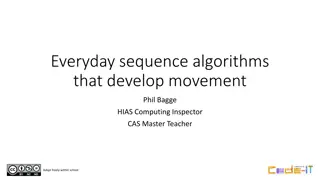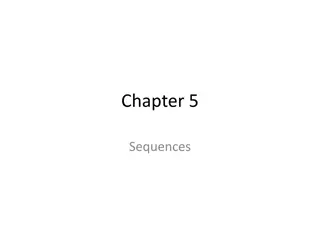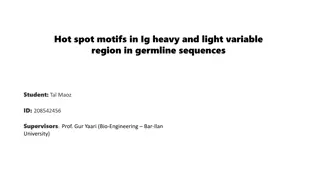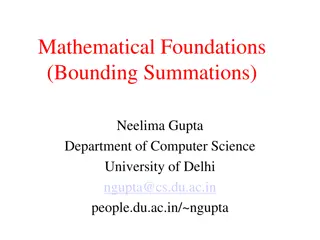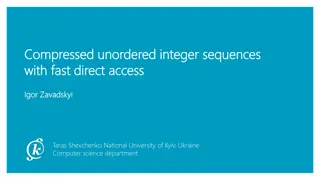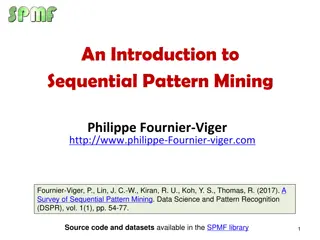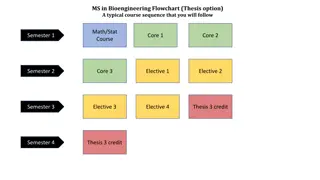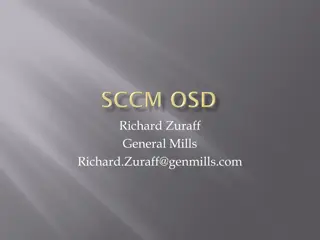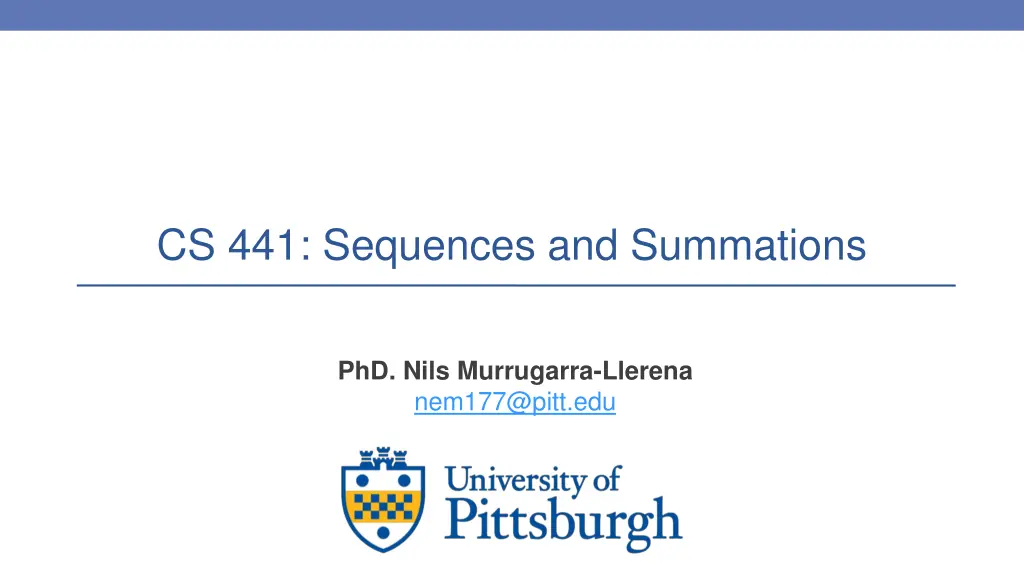
Understanding Sequences and Summations in Computer Science
Explore the concepts of sequences and summations in computer science, including specifying sequences, closed forms of summations, special sequences like geometric and arithmetic progressions, identifying sequence formulas, and solving sequence problems. Dive into the world of ordered lists of elements, functions, and the uniqueness of sequences compared to sets. Unravel the mysteries of sequence formulas and solve intriguing problems related to arithmetic, geometric, prime number, and Fibonacci sequences.
Download Presentation

Please find below an Image/Link to download the presentation.
The content on the website is provided AS IS for your information and personal use only. It may not be sold, licensed, or shared on other websites without obtaining consent from the author. If you encounter any issues during the download, it is possible that the publisher has removed the file from their server.
You are allowed to download the files provided on this website for personal or commercial use, subject to the condition that they are used lawfully. All files are the property of their respective owners.
The content on the website is provided AS IS for your information and personal use only. It may not be sold, licensed, or shared on other websites without obtaining consent from the author.
E N D
Presentation Transcript
CS 441: Sequences and Summations PhD. Nils Murrugarra-Llerena nem177@pitt.edu
2 Today's topics Sequences and Summations Specifying and recognizing sequences Summation notation Closed forms of summations
3 Sequences are ordered lists of elements Definition: A sequence is a function from a subset of the set of integers to a set S. We use the notation anto denote the image of the integer n. anis called a term of the sequence. Examples: 1, 3, 5, 7, 9, 11 1, 1/2, 1/3, 1/4, 1/5, A sequence with 6 terms An infinite sequence Note: The second example can be described as the sequence {an} where an= 1/n
4 What makes sequences so special? Question: Aren t sequences just sets? Answer: The elements of a sequence are members of a set, but a sequence is ordered, a set is not. Question: How are sequences different from ordered n-tuples? Answer: An ordered n-tuple is ordered, but always contains n elements. Sequences can be infinite!
5 Some special sequences Geometric progressions are sequences of the form {arn} where a and r are real numbers Examples: a = 1, r = a = 1, r = -1 1, 1/2, 1/4, 1/8, 1/16, 1, -1, 1, -1, 1, -1, Arithmetic progressions are sequences of the form {a + nd} where a and d are real numbers. Examples: a = 2, d = 2 a = -10, d = -5 2, 4, 6, 8, 10, -10, -15, -20, -25,
6 Sometimes we need to figure out the formula for a sequence given only a few terms Questions to ask yourself: 1. Are there runs of the same value? 2. Are terms obtained by multiplying the previous value by a particular amount? (Possible geometric sequence) 3. Are terms obtained by adding a particular amount to the previous value? (Possible arithmetic sequence) 4. Are terms obtained by combining previous terms in a certain way? 5. Are there cycles amongst terms?
7 What are the formulas for these sequences? Problem 1: 1, 5, 9, 13, 17, Arithmetic sequence with a = 1, d = 4 Problem 2: 1, 3, 9, 27, 81, Geometric sequence with a = 1, r = 3 Problem 3: 2, 3, 3, 5, 5, 5, 7, 7, 7, 7, 11, 11, 11, 11, 11, Sequence in which the nthprime number is listed n times Problem 4: 1, 1, 2, 3, 5, 8, 13, 21, 34, Each term is the sum of the two previous terms This is called the Fibonacci sequence.
8 Sequences are often specified using recurrence relations This is a recursive approach to specifying the terms Later terms are specified from earlier terms For instance, consider this definition of the Fibonacci sequence: ?0= 0 ?1= 1 For any ? > 1, ??= ?? 1+ ?? 2 Note that we need at least one initial condition Like a base case when writing recursive code We ll return to recursion later in the term
9 Sometimes we want to find the sum of the terms in a sequence Summation notation lets us compactly represent the sum of terms am+ am+1+ + an Upper limit Index of summation Lower limit Example: 1 i 5 i2= 1 + 4 + 9 + 16 + 25 = 55
10 Summations are linear: The usual laws of algebra apply ? ? ? ? ???+ ??? ??? = ? ??+ ? ?? ? ?? ?=1 ?=1 ?=1 ?=1 Constant factors can be pulled out of the summation A summation over a sum (or difference) can be split into a sum (or difference) of smaller summations Example: 1 j 3(4j + j2) = (4+1) + (8+4) + (12+9) = 38 4 1 j 3j + 1 j 3j2= 4(1+2+3) + (1+4+9) = 38
11 Example sums Example: Express the sum of the first 50 terms of the sequence 1/n2for n = 1, 2, 3, Answer: Example: What is the value of Answer:
12 We can also compute the summation of the elements of some set Example: Compute Answer: (0 + 2) + (2 + 2) + (4 + 2) + (6 + 2) = 20 Example: Let f(x) = x3+ 1. Compute Answer: f(1) + f(3) + f(5) + f(7) = 2 + 28 + 126 + 344 = 500
13 Sometimes it is helpful to shift the index of a summation This is particularly useful when combining two or more summations. For example: Let j = k - 1 Need to add 1 to each j
14 In-class exercises On Top Hat
15 Summations can be nested within one another Often, you ll see this when analyzing nested loops within a program (i.e., CS 1501/1502) Expand inner sum Example: Compute Solution: Simplify if possible Expand outer sum
16 Computing the sum of a geometric series by hand is time consuming Would you really want to calculate by hand? Fortunately, we have a closed-form solution for computing the sum of a geometric series: Why? So,
17 Proof of geometric series closed form On Whiteboard
18 There are other closed form summations that you should know Sum Closed Form
19 Final thoughts Sequences allow us to represent (potentially infinite) ordered lists of elements Summation notation is a compact representation for adding together the elements of a sequence Next time: Midterm exam review

